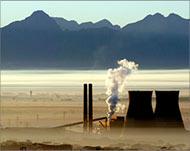Rich nations’ emissions likely to rise
Rich nations’ emissions of greenhouse gases are likely to rise in coming years after a fall linked to the collapse of smokestack industries in the former Soviet Union, UN data showed.

Emissions of the gases, widely blamed by scientists for global warming, were down 5.9% overall in 2003 from 1990 in 40 rich nations including former Communist states.
That beat a goal of a cut of 5.2% by 2008-12 in the UN’s Kyoto Protocol, which seeks to promote cuts in the use of fossil fuel and a shift to clean energy like solar or wind power.
More effort required
“Further efforts are required to sustain these reductions and to cut the emissions further,” the Bonn-based Secretariat of the UN Framework Convention on Climate Change (UNFCCC), of which Kyoto is a part, said in a report.
 |
|
The UN says rich countries must |
It projected that emissions could rise by 10.6% above 1990 levels by 2010 and cautioned that most of the overall cuts were from the early 1990s when high-polluting industries in the former Soviet Union and eastern Europe shut down.
Biggest falls in emissions were in the Baltic states while nations including Spain and Portugal were furthest over the Kyoto targets in 2003.
“Greenhouse gas projections indicate the possibility of emission growth by 2010. It means that ensuring sustained and deeper emission reductions remains a challenge for developed countries,” said Richard Kinley, acting head of the Secretariat.
Climate change
A UN meeting in Montreal, Canada, from 28 November until 9 December will start looking at ways to extend Kyoto and widen it to non-participants including the United States and developing nations like China and India after 2012.
Many scientists say that the build-up of greenhouse gases -from power plants, factories and cars – is driving up temperatures and could cause catastrophic climate changes with more storms, floods, deserts and rising sea levels.
|
“Ensuring sustained and deeper emission reductions remains a challenge for developed countries” Richard Kinley, UNFCCC |
Kinley said Montreal would be the start of a long haul to work out what happens after Kyoto.
“There are, let’s admit it, very wide differences of opinion
amongst governments,” he told a news conference. Asked when a successor to Kyoto might be ready, he said: “Many countries are speaking about something in the 2008-10 timeframe.”
The United States pulled out of Kyoto in 2001 when President George Bush said it was too expensive and wrongly excluded poor nations from the first round to 2012.
Spain highest rise
According to the UNFCCC data, Lithuania had made the deepest cuts at 66.2 percent below 1990 levels in 2003, followed by Baltic neighbours Latvia on 58.5% and Estonia on 50.8%.
At the other end of the scale, Spain was furthest above target with a 41.7% rise in emissions above 1990 in 2003, followed by Monaco at 37.8%, Portugal 36.7%, Greece 25.8 and Ireland 25.6%.
The United States was 13.3 percent over 1990 levels.
Among developing nations, some of which have submitted data for several years even though they have no targets, the UNFCCC said the biggest rise was in Paraguay with a 114% gain in 1994 against 1990 and the biggest fall in Cuba, of 40%.